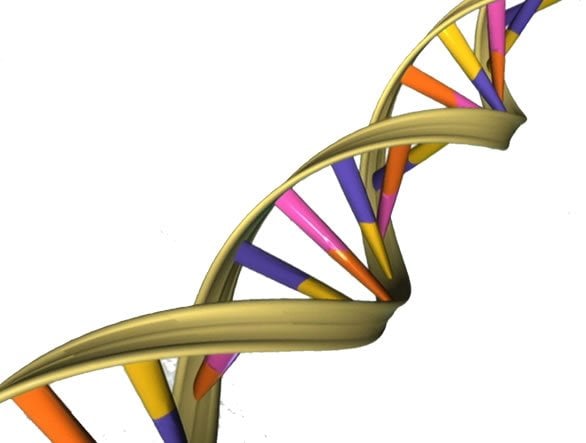New way to identify interacting proteins could identify potential drug targets.
Rhythmic expression of key genes is essential for maintaining proper timekeeping of the body’s clock. In addition, rhythmic degradation of clockwork proteins is also crucial. However, surprisingly, researchers know little about these specific processes.
A new Penn-led study describes a new genome screen that identified partner molecules of cell-waste disposal proteins. The team led by John Hogenesch, PhD, a professor of Systems Pharmacology and Translational Therapeutics in the Perelman School of Medicine at University of Pennsylvania and Jason DeBruyne, PhD, a former postdoctoral fellow in the Hogenesch lab and now an assistant professor at Morehouse School of Medicine in Atlanta, applied their new method to identifying other clock partners that target a multipurpose cell nucleus receptor for disposal. Their findings were published online ahead of print in the Proceedings of the National Academy of Sciences.
“Our goal was not really to study clock biology,” said senior author Hogenesch. “Rather, our aim was to develop a genome-wide screen to identify key players involved in protein stability and breakdown.”
The proteins they were looking for are called ligases. These recognize specific proteins and direct the addition of a molecule onto waste proteins to dispatch the protein to be recycled to the proteosome. This is the cell compartment that breaks up used proteins into its basic amino acids.
To validate the screen, the team tagged several of their favorite clock proteins with a short protein tag that’s easily recognized by antibodies. The team then used high throughput imaging to see what ligases increase and decrease the levels of their favorite clock proteins in cells. They found that the ligase Fbxl3 was a regulator of Cry proteins, critical components of the core clock. They also found that a protein called Seven in absentia 2 (Siah2) is a key regulator of the turnover of a well-studied, clock nuclear protein called RevErbα on a 24-hour cycle.

Certain ligases, like Fbxl3, can be targeted with small molecules. “These ligases are being actively developed in drug discovery efforts,” Hogenesch noted. “Most proteins don’t bind with small molecules. With this screen, we may be able to overcome that limitation by finding the ligase that regulates their levels and function. Small molecules against the ligase, then, could indirectly regulate the amount and therefore activity of the ‘undruggable’ protein.”
The researchers hope that by applying this new method, more ligase drug targets can be found and developed into new therapies across the spectrum of health challenges.
Coauthors are Julie E. Baggs and Trey K. Sato, both from Penn.
Funding: This work was supported by the National Institute of Mental Health P50 Conte Center (MH074924) the National Institute of Neurological Disorders and Stroke (R01 NS054794, U54 NS083932), the National Institute of Minority Health and Health Disparities (8G12MD007602); the National Institute General Medical Sciences (SC1 GM109861), and the Defense Advanced Research Projects Agency (DARPA-D12AP00025).
Source: Karen Kreeger – University of Pennsylvania
Image Source: The image is in the public domain
Original Research: Full open access research for “Ubiquitin ligase Siah2 regulates RevErbα degradation and the mammalian circadian clock” by Jason P. DeBruyne, Julie E. Baggs, Trey K. Sato, and John B. Hogenesch in PNAS. Published online October 6 2015 doi:10.1073/pnas.1501204112
Abstract
Ubiquitin ligase Siah2 regulates RevErbα degradation and the mammalian circadian clock
Regulated degradation of proteins by the proteasome is often critical to their function in dynamic cellular pathways. The molecular clock underlying mammalian circadian rhythms relies on the rhythmic expression and degradation of its core components. However, because the tools available for identifying the mechanisms underlying the degradation of a specific protein are limited, the mechanisms regulating clock protein degradation are only beginning to be elucidated. Here we describe a cell-based functional screening approach designed to quickly identify the ubiquitin E3 ligases that induce the degradation of potentially any protein of interest. We screened the nuclear hormone receptor RevErbα (Nr1d1), a key constituent of the mammalian circadian clock, for E3 ligases that regulate its stability and found Seven in absentia2 (Siah2) to be a key regulator of RevErbα stability. Previously implicated in hypoxia signaling, Siah2 overexpression destabilizes RevErbα/β, and siRNA depletion of Siah2 stabilizes endogenous RevErbα. Moreover, Siah2 depletion delays circadian degradation of RevErbα and lengthens period length. These results demonstrate the utility of functional screening approaches for identifying regulators of protein stability and reveal Siah2 as a previously unidentified circadian clockwork regulator that mediates circadian RevErbα turnover.
“Ubiquitin ligase Siah2 regulates RevErbα degradation and the mammalian circadian clock” by Jason P. DeBruyne, Julie E. Baggs, Trey K. Sato, and John B. Hogenesch in PNAS. Published online October 6 2015 doi:10.1073/pnas.1501204112






